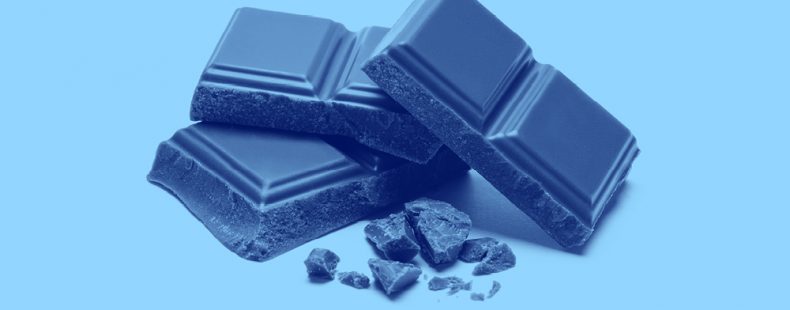World Chocolate Day is something that pretty much everyone with a sweet tooth can get behind. Chocolate is one of the most beloved treats, after all, whether it’s chocolate truffles, chocolate ice cream, chocolate-covered strawberries, or anything else chocolate. But how much do you actually know about this uber-popular sweet? Turns out there’s a lot more to the word chocolate itself (not to mention all of the associated words and variations on how it’s used) than you might imagine.
A brief history of chocolate
The word chocolate was first recorded in 1600–1610. It comes from the Nahuatl word chocolātl, which is thought to be a combination of xococ, which means “bitter” or “sour,” and ātl, which means “water.” It’s a reference to the way that people in Mesoamerica around present-day Mexico had traditionally consumed chocolate for thousands of years: as a drink.
The Olmec, one of the earliest Mesoamerican civilizations, are believed to be the first to drink a beverage made from the beans of the cacao plant some 4,000 years ago. The Mayans and Aztecs followed. Chocolate was variously used for religious ceremonies, as currency, an aphrodisiac, and as a pre-war drink. Chilies and cornmeal were often added as well. Spanish conquerors brought chocolate to Europe, where it was consumed as a beverage sweetened with sugar and honey. After the Industrial Revolution in the 1800s, people were able to make chocolate powder that they mixed with liquid and solidified into an early version of the chocolate bars we know today.
It doesn’t take a trip to the candy shop to know that chocolate is now eaten in many (many) different ways. The word refers to the preparation of cacao seeds that are ground and sweetened, and is used for anything from a chocolate drink like hot chocolate to a chocolate bar to chocolate syrup and chocolate-covered bacon.
Dark vs. white vs. milk vs. bittersweet: which is which?
Along with the various forms that chocolate takes, there are also a number of different styles that it’s made in. The ones you’ll see most often are dark, white, milk, and bittersweet.
Dark chocolate has no added milk. It’s made with cocoa, sugar, and an emulsifier for texture, and sometimes flavors are added as well. You’ll often see a percentage on the packaging—the higher the percent, the higher the amount of cocoa is in the chocolate (and the more bitter it is).
White chocolate sometimes gets a bad rap for not being real chocolate. That’s because it’s made with extracted cocoa butter rather than chocolate solids. Sugar, milk, vanilla, and the fatty substance lecithin are used to make white chocolate.
Milk chocolate, as the name suggests, has milk in it. It’s made similar to dark chocolate in that it uses chocolate liquor (basically chocolate solids and cocoa butter), sugar, and flavorings, but also has sweetened condensed or powdered whole milk in the mix. It uses a process called conching that evenly blends the cocoa butter and other ingredients.
Bittersweet chocolate is dark chocolate that has at least 35 percent cacao. The milk solids comprise less than 12 percent. It’s also sometimes called semisweet chocolate, and packages that are labeled bittersweet chocolate are typically used for baking rather than eating straight. Typically, semisweet is sweeter than bittersweet chocolate, but there are no official guidelines for their content.
A chocolate lover knows: cocoa vs cacao
Two terms you’re bound to hear during any serious conversations about chocolate—and two that are commonly mixed up—are cacao and cocoa. While related, the two words aren’t interchangeable.
Cacao is the small evergreen tree Theobroma cacao. It refers to the whole plant itself as well as the fruit or seeds. It comes from the Nahuatl word cacahuatl. Cocoa, on the other hand, is a powder made from cacao seeds. The seeds are roasted, husked, then ground, and the resulting cocoa is what chocolate producers use to make what you eventually eat.
Other words you need to know to fully understand chocolate
There are plenty of other terms you should know if you truly want to understand one of the world’s most popular treats. Cocoa butter, for example, is the fatty substance from cacao seeds that’s used to make soaps, cosmetics, and other things. And of course you can’t forget some delicious ways to eat chocolate: fudge (a soft candy made from sugar, butter, milk, chocolate, and sometimes nuts), mousse (a dessert made with whipped cream and egg white), truffle (soft chocolate in a hard chocolate shell), and bonbon (a fruit or nut that’s dipped in chocolate fondant).
And as glorious as some of the new chocolate candies and treats are, they didn’t always go by such tasty-sounding names. Case in point: sweetmeat, which is a word that used to be far more common as a term for a sweet delicacy. It wasn’t until about 1300 that meat started to more narrowly refer to animal flesh.
Word list
With the history and background of chocolate in your mind, take a moment to learn about these other common phrases related to this decadent treat. Click here for the full word list, with flashcards and more.
- cacao
- cacao butter
- cacao bean
- cocoa
- confection
- dark chocolate
- white chocolate
- milk chocolate
- semisweet
- fudge
- mousse
- brownie
- truffle
- ganache
- bonbon
- sweetmeat
- candy
- Maya
- Aztec
- Mesoamerica
- Olmec
- Nahuatl
Quiz
Before you take your next bite, test your knowledge on the terms, history, and all things chocolate.
Head over to take the chocolate quiz here!













